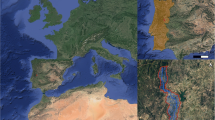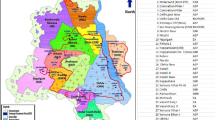Abstract
In an attempt to improve water quality in rivers and streams or to maintain water quality without further degradation, most Environmental Protection Authorities throughout the world set stringent effluent discharge limits on sewage treatment plants. In most cases, these limits are based on Best Available Technology. The use of this technology is expensive, and does not consider the ability of the flow condition of receiving waters in digesting wastewater. An alternative strategy called ‘seasonal effluent discharge program’ (SEDP) was investigated in this study, which utilises different flow conditions in the river, in different periods in order to accommodate various wastewater discharge concentrations. A river water quality model was developed for Yarra River in Victoria (Australia). A genetic algorithm optimisation procedure was used for estimating the reaction parameters and calibrating the model. The river water quality model was then used to study the effectiveness of SEDP. The results of the study revealed that the SEDP is a feasible strategy for improving water quality in Yarra River, since the river has high assimilative capacity in winter compared to summer. This allows a lower wastewater treatment (via a lower chemical dosage) during winter, because of the high dilution capacity in the river.
Similar content being viewed by others
References
Arundel, J.: 2000, Sewage and Industrial Effluent Treatment, Blackwell Science, U.K., pp. 72–104.
Boner, M. and Furland, L.: 1982, ‘Seasonal treatment and variable effluent quality based on assimilative capacity’, J. Water Pollut. Control Fed. 54(10), 408–1416.
Bowie, G., Mills, W., Porcella, D., Campbell, C., Pagenkopf, J., Rupp, G., Johnson, K., Chan, P., Gherini, S. and Chamberlin, C.: 1985, ‘Rates, constants and kinetic formulations in surface water quality modeling’, Report No.EPA/600/3-85/040, USEPA, Athens, GA.
Brill, E., Liebman, J. and ReVelle, C.: 1976, ‘Equity measures for exploring water quality management alternatives’, Water Resour. Res. 12(5), 845–851.
Brown, L. C. and Barnwell, J. O.: 1987, ‘The enhanced stream water quality models QUAL2E and QUAL2E –UNCAS’, Documentation and User Manual Report No.EPA/600/3-87/OC, USEPA, Athens, GA.
Chadderton, R., Miller, A. and McDonnell, A.: 1981, ‘Analysis of waste load allocation procedures’, Water Resour. Bull. 17(5), 760–766.
Covar, A., 1976: ‘Selecting the proper reaeration coefficient for use in water quality models’, US EPA conference on Environmental Simulation and Modelling, April, 19–22, 1976, Cincinnati, Ohio.
Davis, J., Breen, P. and Hart, B.: 1998, ‘The ecology of the yarra river’, A Discussion Paper, Cooperative Research Centre for Freshwater Ecology, Canberra, Australia.
EPA Victoria: 1999, ‘Protecting the environmental health of yarra catchment waterways policy impact assessment’, Report No.654, Melbourne, Australia.
Ferrara, R. and Dimino, M.: 1985, ‘A case study analysis for seasonal nitrification: economic efficiency and water quality preservation’, J. Water Pollut. Control Fed. 57, 763–769.
Goldberg, D. E.: 1989, ‘Genetic Algorithms in Search, Optimisation and Machine Learning’, Addison-Wesley Publishing Company, Massachusetts, 412 pp.
Grefenstette, J.: 1995, ‘A user's guide to GENESIS (Version 5.0)’, Internet, http://www. cs.purdue.edu/coast/archive/clife/Welcome.html.
Gu, R. and Dong, M.: 1998, ‘Water quality modeling in The watershed-based approach for waste load allocations’, IAWQ 19th Biennial International Conference, 21–26 June, 1998, Vancouver, Canada, pp.164–171.
Hamby, D.: 1994, ‘A comparison of sensitivity analysis techniques’, Health Phys. 68(2), 195–204.
Jung, K. and Bau, S.: 1996, ‘Risk analysis for flow duration curve based seasonal discharge management programs’, Water Res. 30(6), 369–1376.
Lence, B., Eheart, J. and Brill, E.: 1990, ‘Risk equivalent seasonal discharge programs for multidischarger streams’, ASCE J. Water Resour. Plann. Manage. 116(2), 170–186.
McCutcheon, S. C.: 1989, Water Quality Modelling, Volume I: Transport and Surface Exchange in River, CRC Press, Boca Raton, Florida, 257 pp.
Mulligan, A. E. and Brown, L. C.: 1998, ‘Genetic algorithm for calibrating water quality models’, ASCE J. Environ. Eng. 124(3), 202–211.
Ng, A. W. M.: 2001, ‘Parameter optimisation of river water quality models using genetic algorithms’, PhD Thesis, Victoria University, Melbourne, Australia.
Ng, A. W. M. and Perera, B. J. C.: 2000, Data analysis and preliminary estimates of parameters for river water quality model development. Proceedings of the 26th Hydrology and Water Resources Symposium, Australia, 773–778.
Ng, A. W. M. and Perera, B. J. C.: 2001, ‘Uncertainty and sensitivity analysis of river water quality model parameters’, Water Pollution —2001, Sixth International Conference on Modelling, Measuring and Prediction of Water Pollution, Rhodes Greece, pp.187–196.
Paz, E.: 1998, ‘A Survey of Parallel Genetic Algorithms’, Internet, http://www.illigal.ge.uiuc.edu.
Reheis, H., Dozier, J., Word, D. and Holland, J.: 1982, ‘Treatment costs savings through monthly variable effluent limits’, J. Water Pollut. Control Fed. 54, 1224–1230.
Rossman, L.: 1990, ‘DFLOW user's manual’, Report No.EPA/600/8-90/051, USEPA, Cincinnati, USA.
Smakhtin, V.: 2001, ‘Low flow hydrology: A review’, J. Hydrol. 240, 147–186.
Thomann, R. and Mueller, J.: 1987, ‘Principles of Surface Water Quality Modeling and Control’, Harper Collins Publishers, New York, 621 pp.
William, R. and Walker, W.: 1968, ‘Low flow criteria for stream standards’, ASCE J. Sanit. Eng. Div. 94(3), 507–520.
USEPA: 1997, ‘Technical guidance manual for developing total maximum daily loads - book 2: Streams and rivers’, Report No.EPA/823/B/97/002, Office of Water, Washington, USA.
Yeh, K. and Tung, T.: 1993, ‘Uncertainty and sensitivity analyses of pit-migration model’, ASCE J. Hydraul. Eng. 119(2), 262–283.
Author information
Authors and Affiliations
Corresponding author
Rights and permissions
About this article
Cite this article
Ng, A.W.M., Perera, B.J.C. & Tran, D.H. Improvement of River Water Quality Through a Seasonal Effluent Discharge Program (SEDP). Water Air Soil Pollut 176, 113–137 (2006). https://doi.org/10.1007/s11270-006-9153-7
Received:
Accepted:
Published:
Issue Date:
DOI: https://doi.org/10.1007/s11270-006-9153-7




